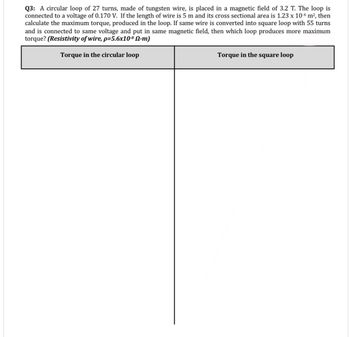Question

Transcribed Image Text:Q3: A circular loop of 27 turns, made of tungsten wire, is placed in a magnetic field of 3.2 T. The loop is
connected to a voltage of 0.170 V. If the length of wire is 5 m and its cross sectional area is 1.23 x 10-4 m², then
calculate the maximum torque, produced in the loop. If same wire is converted into square loop with 55 turns
and is connected to same voltage and put in same magnetic field, then which loop produces more maximum
torque? (Resistivity of wire, p=5.6x10-8 N-m)
Torque in the circular loop
Torque in the square loop
Expert Solution
This question has been solved!
Explore an expertly crafted, step-by-step solution for a thorough understanding of key concepts.
Step by stepSolved in 2 steps with 2 images

Knowledge Booster
Similar questions
- Needs Complete typed solution with 100 % accuracy.arrow_forward2. A slinky is stretched so that there is a gap of 0.95cm between each loop. The magnetic field at the center of the slinky is measured for a range of currents and a graph is plotted of B (in milli-Tesla) versus current I (in Amperes). The result is a straight line with a slope of 0.14 mT/A and an intercept of 0.024 mT. Determine the value of 4 from this result.arrow_forwardThe magnetic poles of the coil and the direction of the current shown in the diagram below are: a. The top part of the coil becomes the North magentic pole and the current will flow in the counter clockwise direction looking down at the top of the coil. b. The top part of the coil becomes the North magentic pole and the current will flow in the clockwise direction looking down at the top of the coil c. The top part of the coil becomes the South magentic pole and the current will flow in the counter clockwise direction looking down at the top of the coil d. The top part of the coil becomes the South hmagentic pole and the current will flow in the clockwise direction looking down at the top of the coilarrow_forward
arrow_back_ios
arrow_forward_ios